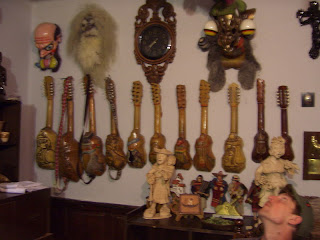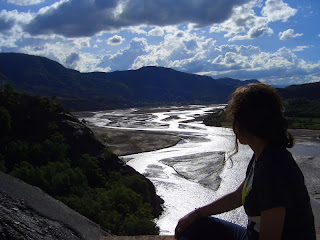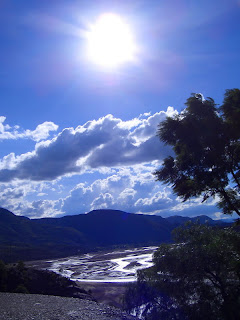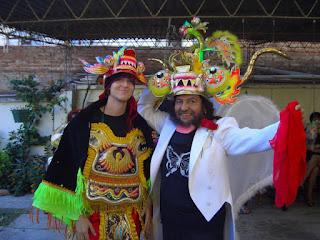
Hola amigos,
School is cancelled today because there are roadblocks all throughout the city. All throughout the country in fact. This is the second day. The buses aren’t running and the center of the city is almost entirely inaccessible. This happens every once in a while when Bolivians are protesting some new law or the lack of a new law. Today bus companies are protesting a new article that fines the owners of buses if their drivers are caught driving drunk. The owners believe that the drivers themselves should be fined because the owners have little control over what the drivers do once they’re in the bus. Some believe it shouldn’t be illegal to drive drunk at all. It is kind of an absurd argument, but they are certainly passionate about it.
Can you imagine something like this happening in the United States? People getting out of their recliners, turning off the TV and blocking traffic for two straight days? To change a drunk driving law? Here roadblock days are like snow days in the States. Kids cross their fingers the night before hoping the protests last a day longer. They watch the news early the next morning for the announcement.

A mural at El Alto University showing indigenous protesters taking to the streets
In 2000 the multinational corporation Bechtel – currently in charge of the reconstruction of Iraq – was forced out of the country for raising water prices. The battle took place in the city of Cochabamba where I live, as tens of thousands took to the streets. Hundreds were wounded in the riots and a 17 year old boy was killed. In 2003 the capitol city of La Paz was surrounded by indigenous activists from the neighboring city of El Alto, the largest indigenous city in the continent. Dozens were killed, including military officials, and the president was pressured to resign. It is a completely different kind of political participation here. 93% of the population votes in elections, but the elections are only the beginning of the popular political process.
Anyway, so with my day off I slept late and played charango (an Andean guitar-type instrument) for two hours. Thank you protestors. Now I am somewhat vainly trying to muster myself out of this laziness to update my blog. Here we go.
I spent the last nine days in the two extremes of Bolivian society: the first four in its largest city of La Paz, the last five in a small indigenous village of 24 families on the shore of Lake Titicaca. La Paz was neon, flashing, pungent, rambunctious, overwhelming, like having the volume turned up full blast and blowing out the speakers. The indigenous village was ambling, lazy, silent, a steady inhaling and exhaling, like the tide of the lake on the rocky beach, versus the hyperventilating bustle of La Paz’s traffic jams and espresso shots. After a few days of rest my mind is still swirling with exhaustion trying to synthesize all the very different ways there are to live in the world.

Me posing goofily with some of the young radicals being educated at the University
Some brief details on La Paz and then way too much rambling about nothing in particular
I spent much of my time in La Paz wondering around the Witches’ Market absorbing the sights and smells. Many street vendors offered an impressive array of llama fetuses. They looked like dehydrated corpses of Martians found wrinkled and stiff in the desert. Their shriveled bodies hanging in clusters from the store roofs was slightly disconcerting. Some indigenous people around the city use the fetuses for sacrifices to Pachamama. I thought about buying one and bringing it home as a souvenir, but I assumed it would look suspicious in my carry-on. At other stands hallucinogenic peyote cacti were offered to me for about $3 American. Chop the cactus up, steep it in boiling water, strain and drink for a good time, the woman informed me. I declined. I did however buy a large bag of fresh aloe vera juice squeezed from the largest aloe plant I’ve ever seen. It feels sticky and disgusting applied to my sun burnt face, and it has a vague semen kind of smell, but it seems to be doing the job.

A collection of bizarre plants
I visited the Coca Museum in the Witches’ Market to learn about the history of the most sacred plant of the Andes. The Incans used oil extracted from the leaves to remove brain tumors. It’s been found buried with mummies over three thousand years old. It is one of the most nutritious plants in the world, with more calcium than milk and almost as much protein as meat. It helps with indigestion, headaches, and altitude sickness, particularly important up in the Andes Mountains. The leaf is still chewed all across the country and used in a variety of ceremonies. They chew it like we drink coffee and tea in the United States, as a mild stimulant to start the day fresh or as a social lubricant in gatherings of friends. It is also made into tea, cosmetics, lotion, candy, cookies, and, as I later discovered, a delicious chocolate cake. I went back for the cake a second time.

More notoriously, of course, it is used to make cocaine. I saw an exhibit using a series of mannequins to demonstrate its production. Poor campesinos are used in forced labor to stomp on the leaves with a mixture of hydrochloric acid and other noxious chemicals to extract the powder. Afterwards their feet are mutilated from the concoction and many cannot walk for the rest of their lives. For millennia the plant has been used for health, ritualistic and social reasons. Now it is being used to indulge the habits of rich frat boys and rock stars in the United States and Europe.
Bolivia kicked the DEA out of the country for trying to annihilate its fields of coca through excessive and inaccurate use of herbicides that killed more plants than just coca, as well as through other more direct tactics such as burning campesinos’ farms to the ground leaving them with no livelihood whatsoever. Everyone is much happier without the DEA here. Except, of course, the United States. The Bolivian government’s rational is logical: the drug war is a case of supply and demand. As long as there is demand in the United States, there will be supply in Bolivia, Peru, Colombia and Ecuador. Fighting the supply side will never work, especially when the supply is a plant that grows natively all throughout the region in all kinds of climates. La oja de coca no es druga, proclaims a popular shirt in Bolivia.

A 16th century church outside of La Paz
 The inside of the church, complete with paintings of Jesus in modern times fighting with guns in the revolution
The inside of the church, complete with paintings of Jesus in modern times fighting with guns in the revolution
Later we visited the World Bank and were given a presentation by a cheerful PR type. The World Bank has a tainted reputation in the so-called “developing” world for giving loans to elites with bad credit records who are in charge of the government. The people have no say in the matter, but they are the ones affected when the country’s economy is crippled trying to pay the high interest rates attached to the loans. The loans are also given with “conditions,” meaning a country must become a capitalist country open to exploitation by multinational corporations, otherwise they don’t receive any money. Once again, the decisions are made by already rich elites who aren’t affected when the masses can’t afford to buy water and fuel because its been privatized.
Ecuador refused to pay its debt and kicked the World Bank out of the country. So did Venezuela. After the earthquakes in Haiti the World Bank offered $100 million but only under very strict economic conditions that would’ve privatized much of the country. There was such a backlash against the idea that the Bank removed the conditions and gave Haiti the money ideologically free. The Bank exists in a reduced form in Bolivia today. Our PR man told us that “The Bank’s one goal is to stay alive, and it will change its politics for the sake of staying in a more liberal country such as Bolivia.” Sounds like a parasite to me.
A Bank of the South has also been established in South America that one day will likely replace the World Bank altogether, giving the continent agency over its own finances. It’s kind of like growing up and getting your own bank account instead of only getting money from your parents when you say the right things and do all your chores. The United States and the rest of the Western capitalist world still thinks it can treat South America like an infant.


Said a friend at the sight of La Paz sprawling across the mountains: "Urbanity: cooler than anything nature could ever do." My response: "Urbanity is nature, dude."
Later that same day we visited a feminist anarchist group called Mujeres Creando (Women Creating). One of the largest, most powerful capitalist organizations in the world followed by an anti-organization, anti-capitalist art activist collective in the course of a few hours. I would’ve loved to see the two groups debate each other.
The cognitive dissonance caused by the two groups predictably set off a few arguments among the students. The next day at lunch I had a talk with some friends about the best way to change the world. Us young idealistic types do this a lot. Like most of the students on this program, they were International Relations or Political Science majors, interested in using NGOs, politics, and, most importantly, money, to help people. We need to go into struggling, poverty-stricken countries like Bolivia, Guatemala, and Haiti, set them up with clean water systems, modern technology, modern agriculture. We need to build functioning democracies and successful businesses. Business is the most important part. Sweatshops are a good thing, they say, because anything that creates jobs and brings money to a country cannot be bad. We need to help these countries develop. We need to increase GDP, decrease inflation, raise this number, lower that one. It doesn’t matter what’s actually happening on the ground, it matters what’s happening on the graph.
I have a somewhat different perspective. As someone with admittedly very little knowledge of economic systems, I can approach the subject only from an intuitive level. But I don’t think expertise in a field really makes you any more qualified to have opinions than anyone else, because everybody is an expert on something and we all disagree with each other, so expertise really hasn’t done anything except make everybody more sure of why everybody else is wrong. So because of this I had no reservations in voicing my extremely unqualified positions.
I think the only change that has any lasting effect is change that comes from within a system. We humans are obsessed with trying to control things beyond our control, and foreign aid, development projects, the World Bank – all of these things – are instances of this. These are all instances of external change, of foreigners coming into a developing country and telling them how to improve their situation to join the developed world. It is imposed change rather than organic change. Imposed change can only be superficial because society is not restructured from the bottom-up, but from the top-down, and a pyramid balanced on its point rather than on its base will always crumble.
It’s like when the United States imposes democracy on another country (*ahem* Iraq) rather than allowing that country to fight for democracy on its own. In the short term the project will seem a success because there will be the illusion of democracy, but in the long term the project will fail because the people did not invent and build it themselves but unwrapped it fully formed as a gift. Think of how different our country would be if France had won the American Revolution for us rather than merely helping us to do it on our own. When change is external, the society becomes dependent on that external change to solve its problems as opposed to taking ownership over its own internal change. External change comes and leaves, but internal change can perpetuate itself.
As the saying goes, the journey is more important than the destination, because the journey is where principles are built gradually for the support of strong actions. By jumping straight to the destination – as is the result of external change in the form of imposed democracies, imposed capitalism in Latin America, imposed charity from many NGOs – the journey of internal change is lost and any outcome is an apparition floating precariously in the air, seemingly in flight but really just nose diving to the ground.
The whole idea of “development” is an imperialist, ego-driven masturbation. Third world and first world, developing and developed, savage and civilized – these are all colonialist terms that imply only one possible course of evolution, with our own society obviously being the standard with which to compare all others. Development projects seek to force other countries into our own evolutionary path rather than allowing them to become uniquely successful on their own merits. We are striving towards the creation of a globalized, monocultured, capitalist world, and everything I have learned about biology seems to suggest that diversity always wins over uniformity.
It’s like in the 70s when ecologists decided there weren’t enough deer in the wild. Wolves were killed and more deer were introduced. Now, in the 2000s, ecologists have decided we have way too many deer and not enough wolves. Rather than allowing a system to regulate itself internally, humans pretended to understand and took action. In every system an extremely complex tangle of variables exists. When outsiders come in with chainsaws and strike dumbly and bluntly at everything between them and their goal, it is no surprise to me that things fall apart.
So what do we do then to change the world? Surrender control? Not try to help people? Of course not. But I think there needs to be more focus on solving problems in our own countries rather than solving everybody else’s. So many problems in the world exist as the result of Western capitalism, of which the United States is home base, that if we really want to help peasants in Africa and South America, we will focus on reforming the politics and economics of our own country. The United States affects so much of the world both directly through its economic policies and indirectly through the model it sets. If we change our country, the world may follow.
And I personally think the best way to do that is through art rather than politics. The tool of politics is money, and because money is the cause of so many problems, more money is not going to solve anything. Money creates so-called “band-aid solutions,” like an anemic person putting bandages on their cuts rather than changing to a diet with more iron. I think art is what fuels the hopes and dreams of a people, and as I discussed in a former post, dreams are what determine the future of a country.
When Abraham Lincoln freed the slaves, racism did not vanish. When blacks were given the right to vote, racism did not vanish. When Barack Obama became president, racism did not vanish. Racism will not vanish on any account of government. Neither will any other prejudice. Something else is required. All of progresses in the fight against racism were not the triumph of government – they were the triumph of culture. Government is always a reaction to culture, and government is always many steps behind, especially when that government is full of old white men whose only interaction with the world is in a mansion or private jet. Because democracy is a slow and bureaucratic process where officials must be elected and must draft and vote for and redraft laws, it cannot keep pace with a rapidly changing culture.
Government often exists as an inconvenience, a barrier to social change. It is only helpful when it is decreasing its power in regard to social freedom – giving blacks and women the right to vote, legalizing gay marriage, legalizing alcohol or marijuana... these are all the result of government decreasing its role as it finally succumbs to pressure from a culture that has outpaced it.
I think government can be useful in battling the damage of capitalism such as through universal healthcare, social security, and other kinds of economic regulation, but I also think these problems could be solved without the use of government, by people abandoning these economic systems altogether and creating something new based on human-to-human interaction rather than bank account to bank account. We make a distinction between sex for love and sex for money, scornfully labeling the latter “prostitution.” If this is true then is not every exchange done for money rather than love a kind of prostitution? If prostitution is to be scorned, so should selling food, selling books, selling anything. I think we can strive towards something new and I think art can create dreams for this new something.
I define art loosely – any work created by people with the intention of connecting with people: a website, a piece of music, a poem, a thoughtful conversation. These are interactions that take place from one human being to another, and their effects cannot be quantified. You can sell a piece of art, sure, but I think there is also something inherently anti-capitalist about art, even that which is sold. Anything that comes from a place of truth and love is priceless, and what is priceless is subversive to a system that worships capital.
Here’s a Charles Bukowski quote I like: “The only way to save the world is one life at a time. Anything else is romance or politics.”
Anyway, if you read all that, good for you. I could ramble on for pages more but I lost track of what I was talking about a long time ago. I don’t think my friends are wrong in wanting to help the world by bringing clean water and food to those that don’t have it. These are admirable goals. I just don’t know how effective they are at systemic change which would save more lives in the long run. Maybe you need both approaches. An anemic person still needs to put bandages on their cuts so they don’t get infected. But all the good intentions in the world will not keep bad things from happening in a society that is spiritually anemic.
And please, feel free to disagree with anything or everything that I write. I’m mainly writing to see what I think, because I don’t exactly know, as I tend to think many contradictory things at once. I disagree with myself from one moment to the next. I've also always wanted to be a musician or writer. Perhaps I am just finding ways to justify my dreams over those of others. In the end I don't think any of us can claim to know the only right path because there are an infinite amount of options.
I’ll tell you all about my indigenous village stay in the next post. It’s raining now and it sounds great on my tin roof and I want to listen to my new CD and go to sleep.
Love,
Tom
-----------
P.S. Here are a whole bunch of pictures of Tiwanaku, a massive site of ancient ruins in northern Bolivia. The city supposedly hosted anywhere between 60,000 to 100,000 people, with its peak around 1100 AD. The site shows evidence of extensive agricultural terracing, irrigation systems, massive ceramics production, a sewer system and intricate stonework. A few different societies lived there over the ages. It was suddenly abandoned sometime around 1200 AD, no one is sure why. The Incans believed the inhabitants were all turned to stone because they offended the gods, thus explaining all of the statues.
Spooky.

The Gateway of the Sun; on the Solstice the sun rises in the arch






Our guide Oswaldo, the leading archaeologist at the site






Priests-in-training would live in this underground room for a few days to be reborn... How archaeologists know this about a site a thousand years old from a society with no written records, I have no idea. The tour led me to believe that 80% of archaeology is just saying things that sound cool with no real evidence.


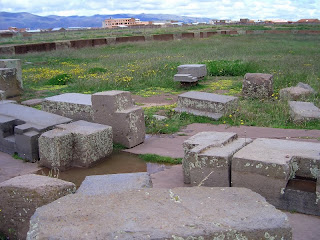


The ancestor of the domestic potato: this variety is completely inedible and even a little poisonous. Why and how did early humans decide to grow it for food?
 But definitely a ton of fun. Cameron does a backflip.
But definitely a ton of fun. Cameron does a backflip.








